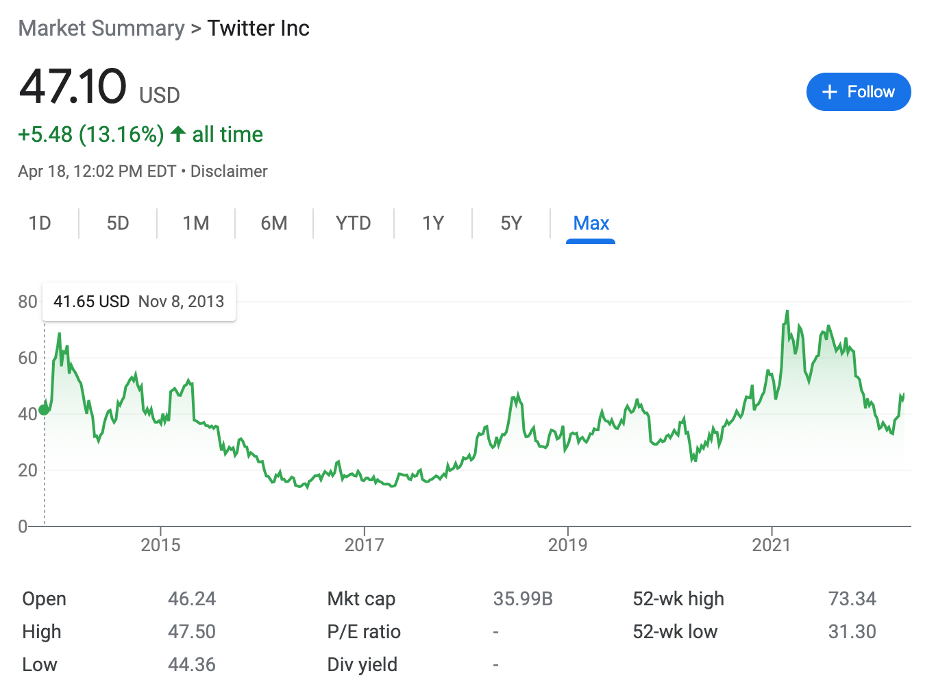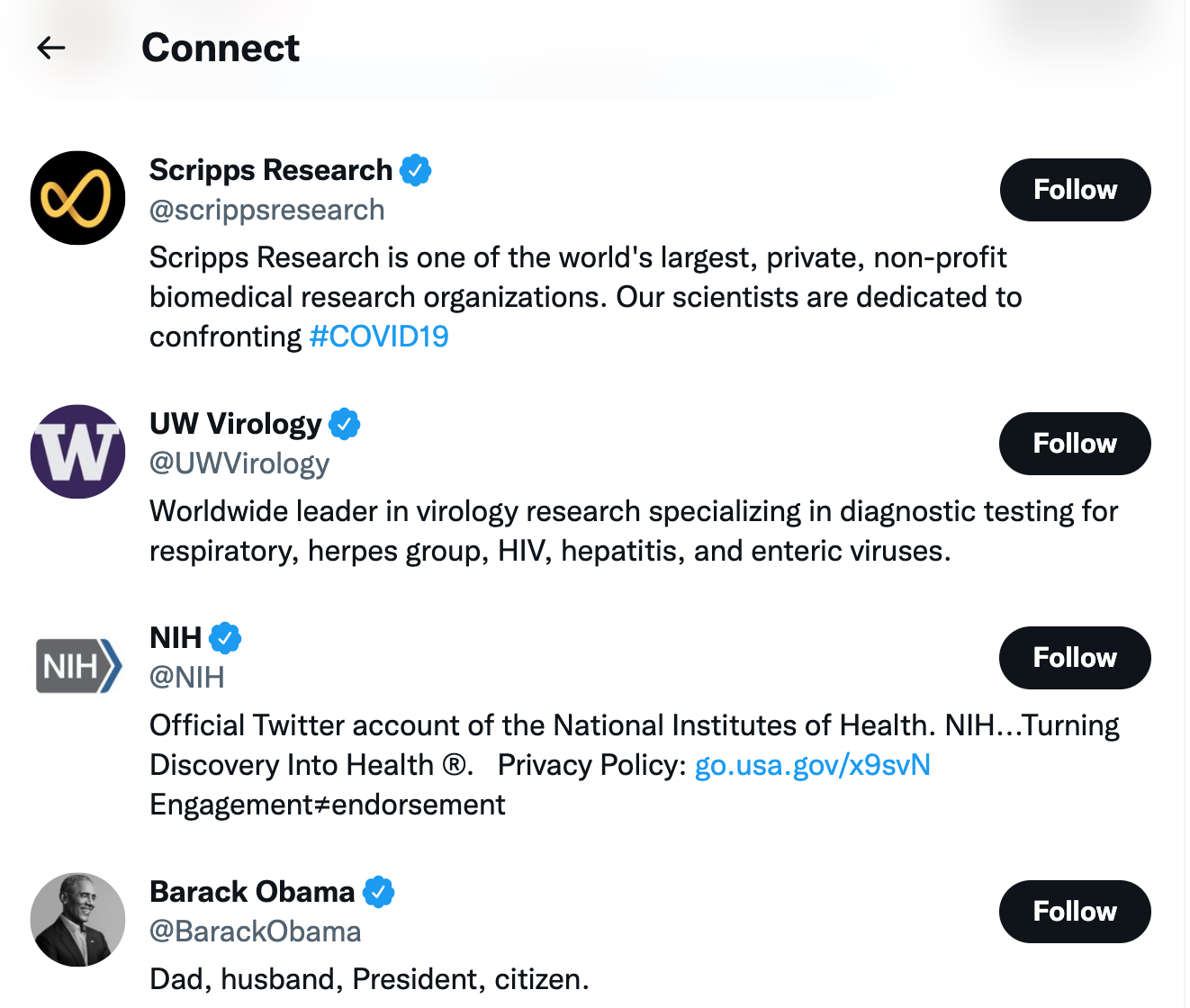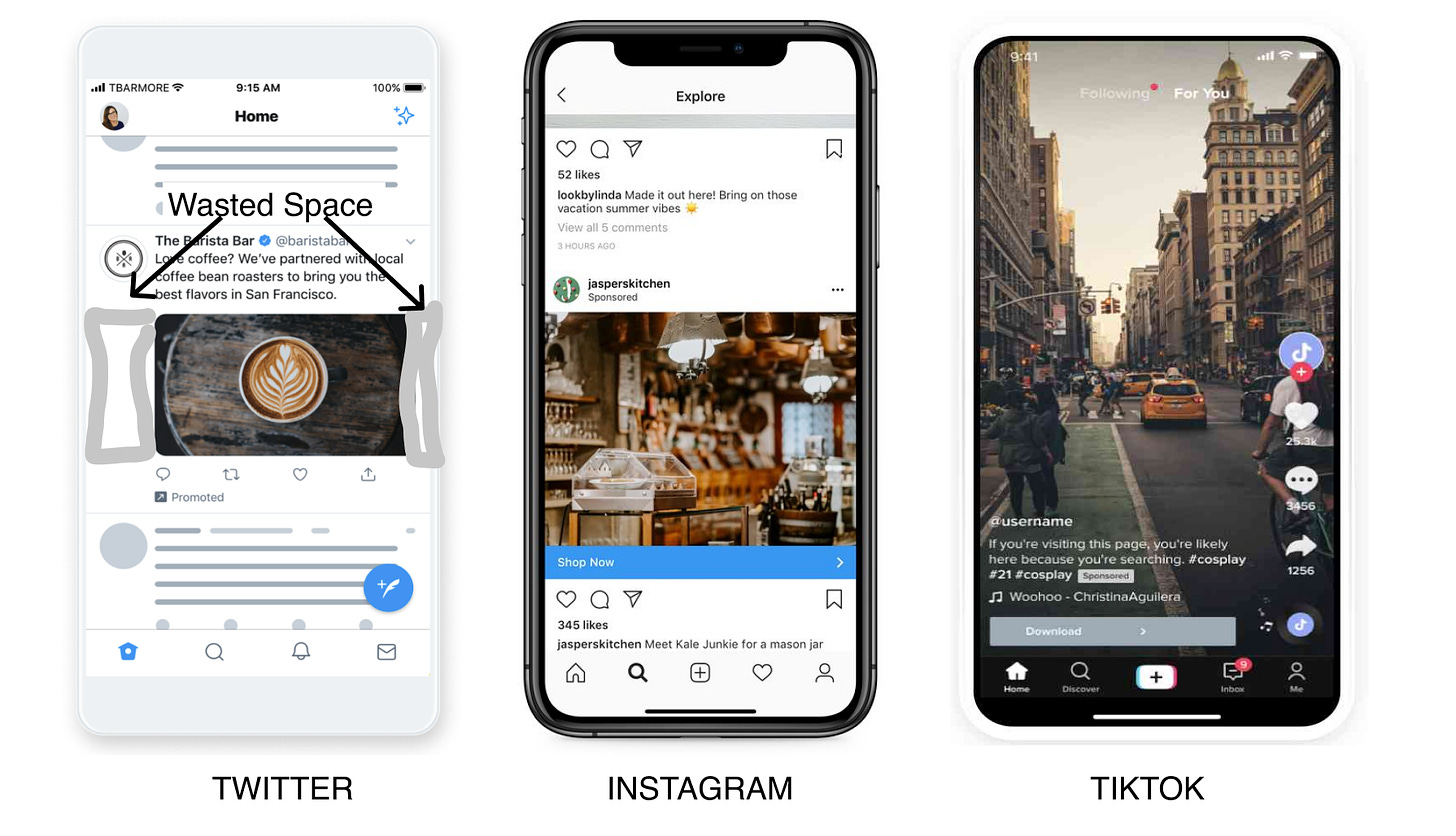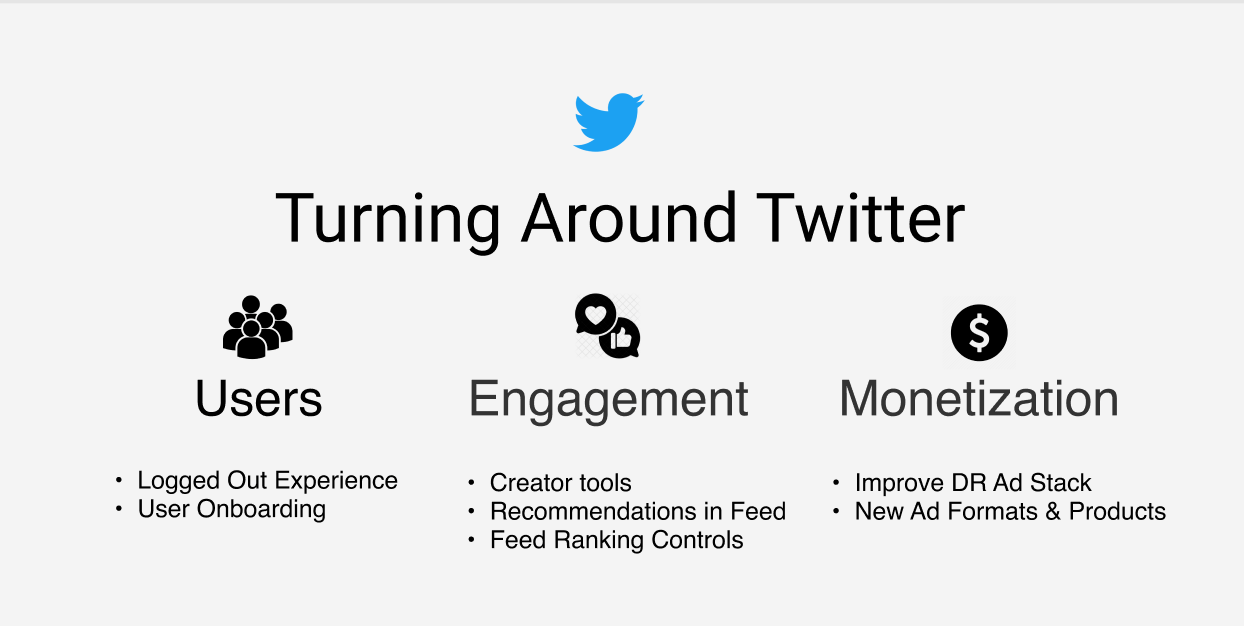Hi friends,
You are probably aware of Elon Musk’s offer to purchase 100% of Twitter for $43B. While his offer focuses more on the free speech aspect of Twitter with him saying “I don’t care about the economics at all”, those familiar with the company no doubt know that the business and the stock has floundered since its IPO, with the stock within 10% of its IPO price ~8 years later.
There’s been a lot in the news about whether Musk’s plans will go through and what other bidders may come in. But instead, I’ll touch on how one might turn around Twitter as a business.
The key factors
One simple way to think of a social network like Twitter is to think of its “formula” for success as Users x Engagement x Monetization.
More formally, the equation for the overall Revenue the business generates can be thought of as
Revenue = Number of Users (Users) x Engagement Per User (hrs/user) x Revenue Per Engagement Unit ($/hr)
Given these three broad buckets drive the overall value, let’s talk about how Twitter can improve on all three over the coming years.
Users
A lot of the world is familiar with Twitter in that they have either tried it or seen tweets on Television or linked in articles or screenshots of other social networks (LinkedIn, TikTok, Instagram, Facebook, etc.). But only ~217M users use it daily. This despite over ~1B users having made accounts, and likely another billion or two having interacted with the service.
So how can Twitter grow that 217M number which use the service daily?
1/ Improve the logged-out experience
Given how many users are likely to find a tweet via other services and land on Twitter, Twitter’s logged out experience has room for improvement.
First, Twitter should optimize the experience on a single tweet page for a logged-out user. They already show some similar tweets to the one in question, but force a signup upsell immediately, arguably too soon before the user has seen any real value. While the aggressive upsells have worked for TikTok it doesn’t seem to be working as well for Twitter.
Second, Twitter should make the login recovery flow easier for users with accounts. While FB and Instagram have invested a lot of resources in making sure logging in is as easy as possible while remaining secure, Twitter hasn’t, and I know of anecdotally a few people that got locked out of their accounts and were forced to create new ones.
Lastly, Twitter can explore a potential partnership (or threaten takedown of their content) with the other social networks where screenshots of Tweets have to be deeplinked back to the original tweet or the original author of the tweet notified. The amount of people seeing Tweets on Instagram, Facebook, TikTok but never using Twitter is ridiculously high. This would grow the top of funnel of users coming onto Twitter’s service.
2/ Improve the onboarding experience
Much has been said for years and years about Twitter’s onboarding experience, but it still has room for improvement.
The primary goal of onboarding should be to learn about a user's interests and deliver a timeline to them even if they don’t follow anyone, and to teach them to start following people over time. As their “following” base grows, the suggested / recommended tweets in their timeline should reduce in favor of tweets from their followers.
Today, Twitter’s “who to follow” is too biased to extremely large accounts and brand accounts (publications, sports teams) – instead, Twitter should recommend more niche accounts with fewer followers that are actually likely to follow back and engage with responses were the new user to reply to them.
Twitter also needs to lean in more to it being an interest based social network. While encouraging people to find their friends is important to kickstart the graph for people, it is arguably more important to seed the social graph with the right interests and interest-based accounts for users to likely retain on the platform. Over 350M accounts on Twitter don’t have a single follower and Twitter isn’t doing enough to make sure onboarded users find their tribe.
The last part is that for new users to post and see value in posting and retain that behavior, Twitter has to make sure users receive enough feedback on their early posts. This is where Twitter can take a page from TikTok and ensure that new users’ content gets some minimum distribution by upranking it and showing it in the suggested content for potentially interested users even if they don’t follow the new user. If those posts tend to receive high engagement when upranked, they can continue to get amplified resulting in new users finding more followers (in their interest niches) sooner.
Engagement
All social networks require:
good content to be produced on it and
making sure this content can effectively be consumed by people interested in it.
Twitter arguably does well on the production side although there is always the potential to get better and even that might be at risk in the long-term. On the consumption side, there is clear room for engagement growth, given that on a per user basis time spent on twitter is lower than other platforms despite having a smaller (and more specific user base).
1/ Attract and Retain Creators on the Platform
Twitter is fortunate in some sense that so many people and creators are creating great content on the platform for free. But over time, creators in some of the areas it excels in – politics, business, news, sports and others – may leave or start putting their best content elsewhere to better monetize their following. And we are already seeing some of this happening with the rise of Substack, Patreon, The Athletic, etc.
It is important Twitter improves its offerings for creators to continue to grow and also effectively monetize directly on Twitter – but not so that Twitter can make more money through commissions on these, but so that creators come onto and continue to post content on Twitter.
Some key aspects of this include:
A better newsletter offering (the Revue acquisition was a good move)
A better long-form product (Threads 2.0) integrated with the newsletter / paywall
More monetization features for creators that are prominent such as tipping, unlocking access to content / threads and affiliate
Continuing to copy (Spaces) and innovate on organic formats that fit with Twitter (but not blindly copying everything like Stories).
2/ Lean into Recommendations in Feed
When you consider two things:
Most Twitter users don’t have a well curated graph of people they follow.
Twitter is an interest based social network
It makes it clear that Twitter should be more aggressive about showing recommended or suggested tweets based on the topics a user is interested in to them. And not just in the secondary tabs on Twitter but directly in their home feed. The amount of these a user will see will obviously be based on how much “connected” inventory (i.e., from people they follow they have to see) and how those compare and rank versus the “unconnected” things you could show them for their interests.
Over time, Twitter has improved its interest graph and now can categorize tweets by topic in a semi-okay manner (e.g., Gardening, Formula 1, Venture Capital, New York Knicks), and they should leverage this to show most of the casual / average users the very best content on Twitter directly related to their interests. They’re trying to increase the “inventory” of things they can show users by showing things liked by people they follow and allowing them to follow topics, etc. but they should just go a step further and show the best stuff they can.
What about the people who are more power users and have a carefully crafted graph on Twitter? That’s where the next thing comes in.
3/ Improve Feed Ranking and Controls
Obviously, some people wouldn’t want recommended content since they manually curate their feed. For example, many people already dislike that Twitter sometimes shows them posts just liked by (as opposed to posted by) people they follow.
That’s where improved controls in feed ranking come in. Users should be able to select and unselect certain things they don’t want to see such as:
Suggested/Recommended content
Content liked by people you follow
Content commented on by people you follow
Threads
Factchecked / Potential Misinformation / Flagged Content
In addition, when users see something, they didn’t like such as a thread, the dropdowns should be more specific and allow users to essentially press “see less like this”, where the algorithm likely learns that they meant the thread format as well as the topic (or just the format and not the topic or vice versa) so that it improves ranking in the future.
Lastly, perhaps the ranking algorithm itself should be public with users being able to export their algo preferences and import algorithms created by other users based on their beliefs, which might address some of the (lack of) free speech concerns with Twitter.
When combined with more recommendations above, these features can help users see better content which should encourage them to use Twitter more often and spend more time on the platform.
Monetization
While people typically compare social networks on a revenue per user basis, even on a revenue per user per hour basis, Twitter lags other social networks.
One of the key reasons for this is that Twitter’s revenue is 85% brand advertising oriented, while most other social networks tend to be 60%+ performance (i.e., direct response) advertising.
The benefits of performance advertising are that results are more easily measured and more tied to business outcomes, and so as long as a platform shows a good return on ad spend for an advertiser (which is easier to measure for performance than for brand), advertisers will continue to spend and even increase spend on the platform. In addition, it is easier to increase CPMs over time as a platform if you improve efficiency of outcomes and targeting and so in some sense a lot of the benefit of improvements in targeting, measurement can be “captured” by the platform.
1/ Improve DR Advertising Stack
Twitter arguably found itself in a better position with the iOS changes given their weakness and failings thus far in DR advertising. But this isn’t a reason to rest on their brand business. For Twitter to improve their $/hr, they must improve their Direct Response Ad Products.
This involves several factors including:
better targeting (more focused on interests than demographics since Twitter excels at the former)
better measurement and attribution
changing sales incentives to continue to focus on DR
building better tools to allow advertisers to tell Twitter what conversions took place in an App Tracking Transparency world via conversion APIs that advertisers can use to report conversions.
Given Twitter’s scale and DR advertisers being sophisticated and data-driven and always looking for new platforms given rising costs on some of the larger ones, if Twitter can deliver high ROAS DR ad products, there is no question that the budgets will move over to Twitter.
2/ Innovate on Ad Products and Formats
Tied closely to the above, Twitter needs to innovate on its ad products and formats, some of which will also involve innovating on organic products, particularly on the video side.
On the format side, one glaring thing to me is in a world that’s moving towards more immersive, full-screen, video-based ads, how non-immersive and boring a lot of the ads on Twitter are. One obvious difficulty with Twitter is the primarily text-based nature of it. However, by making media on posts full-bleed (today the videos aren’t edge to edge) and allowing say 9:16 vertical photos and videos (both organic and ads), they can at least try to increase the usage of more media from advertisers and improve performance.
On the products side, given we’re in a signal loss world where it might be harder to glean which users are actually “converting”, Twitter needs to build better products that allow for discovery and consideration on platform. One obvious area they’re working on is shops and commerce, which would allow them to potentially get some signal on what users are interested in purchasing. Another area might be native subscription ads for things like journalism, media, etc so that say NY Times or Spotify or Netflix can run ads which allow users to sign up directly from the Twitter platform. Likewise, given Twitter’s strength in brand advertising today, they should continue to innovate on new brand advertising formats that users will engage with.
Closing Thoughts
While the above captures some of the key areas of the business and product Twitter has to improve on to continue to grow users, engagement and revenue, there are also some underlying things which need to change for some of the above to even come to fruition.
They include:
Fixing the technical debt which has plagued Twitter and prevented them from moving quickly and shipping features.
Continuing to improve on and adopt their culture of experimentation, failing fast and a bias to shipping they seem to have adopted over the last 12-18 months. I viewed the launch and quick killing of Fleets as a good thing in that sense (though perhaps it might have been clear it lacked fit on a platform like Twitter even prior to building).
To become leaner over time and not overstaff teams and have unnecessary layers. In speaking with people there, too many cooks in the kitchen has been called out as a reason they have moved slow in the past. This bears out in the numbers too. Twitter has ~33% more employees than SNAP which actually has 50% more daily users. This will also help them improve their bottom line, which of course will help drive free cash flow and so business value. For context, Twitter’s margins today are ~11%, but as FB has shown, it’s possible to run a social network at 40-50% margins.
Thanks for reading! If you liked this post, give it a heart up above to help others find it or share it with your friends.
If you have any comments or thoughts, feel free to tweet at me.
If you’re not a subscriber, you can subscribe below. I write about things related to technology and business once a week on Mondays.








